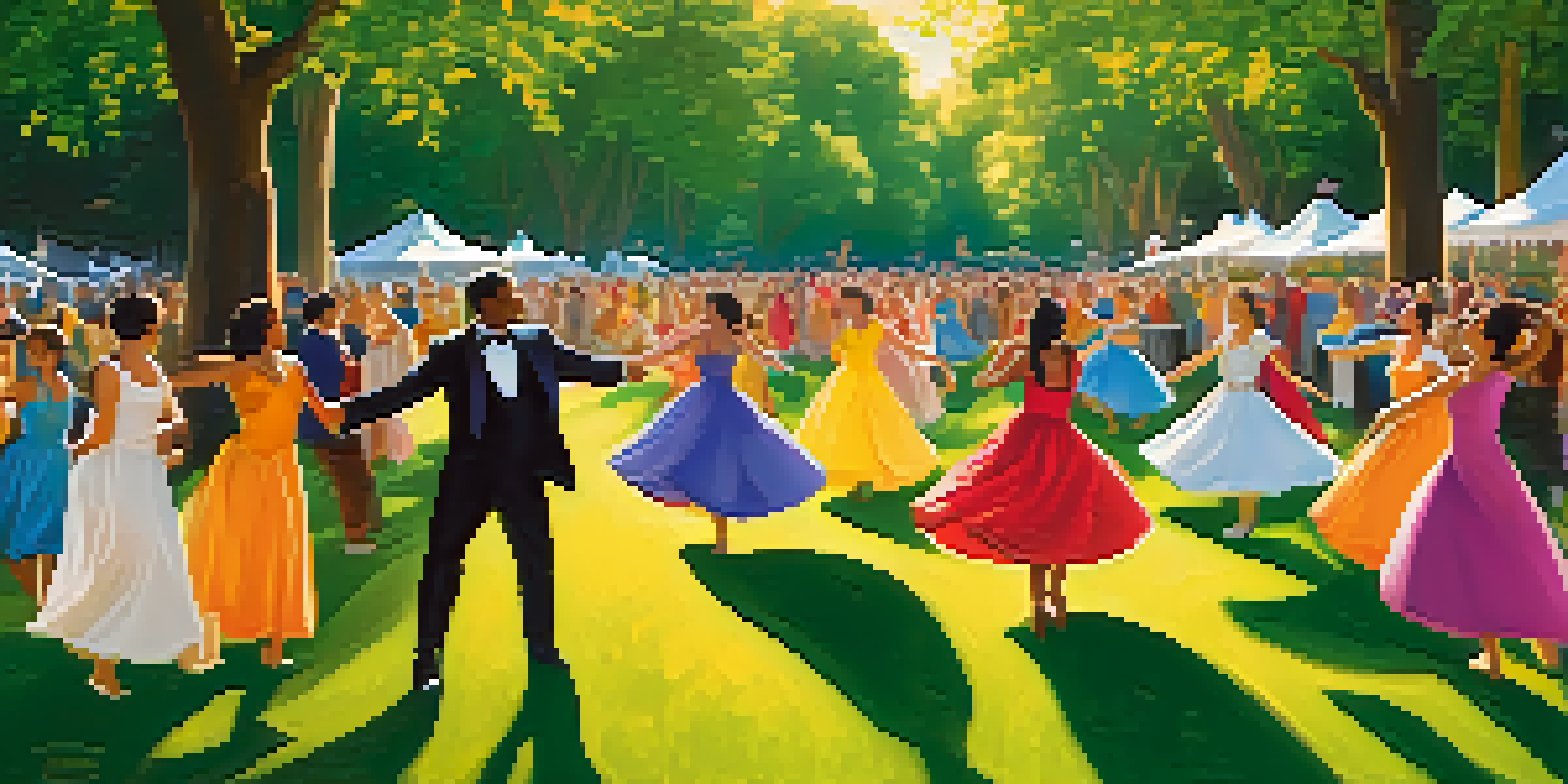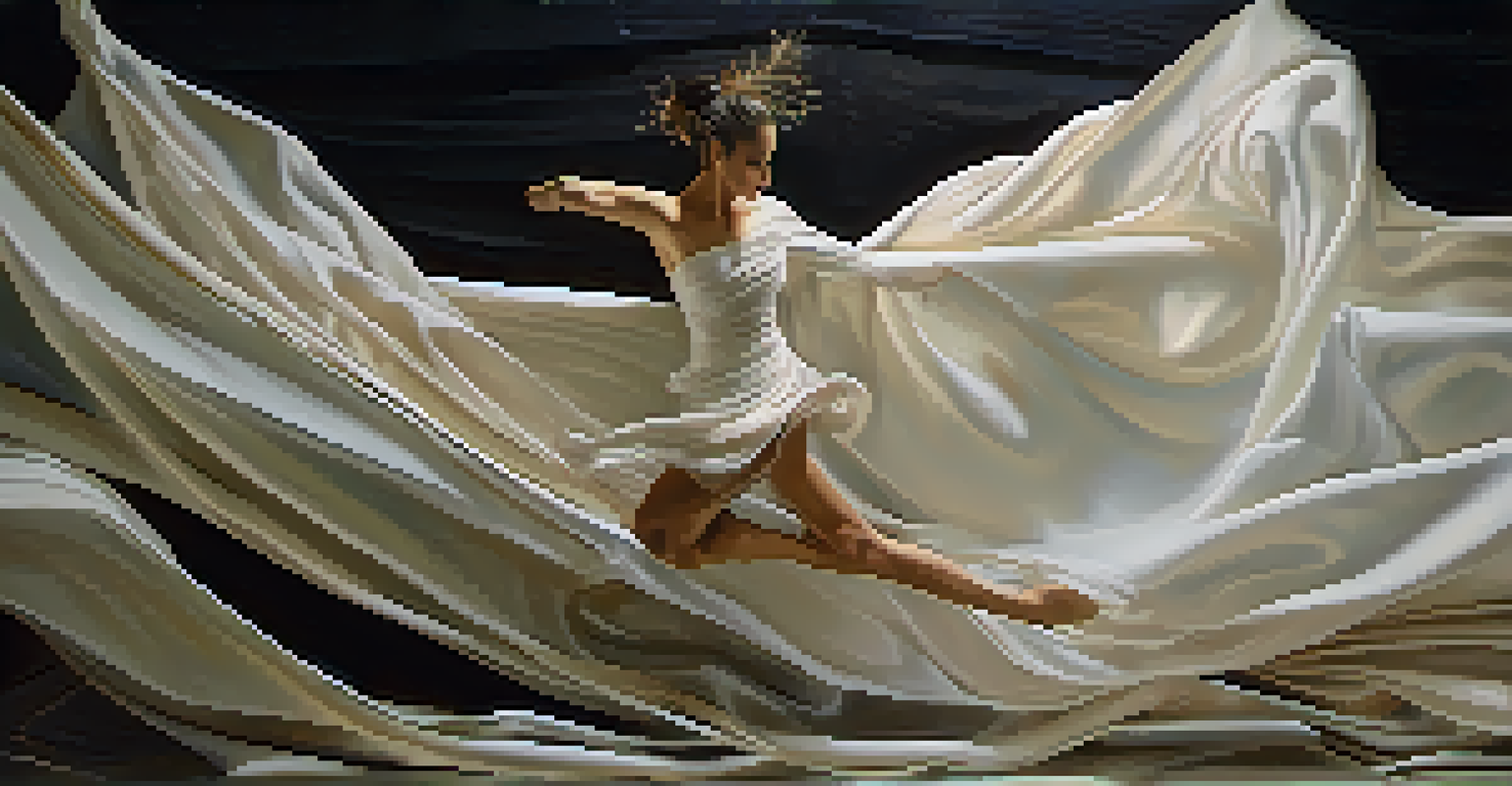The Role of Dance in Environmental Sustainability Initiatives

Dance as a Universal Language for Environmental Awareness
Dance transcends cultural boundaries, making it a powerful tool for communication. By incorporating themes of nature and sustainability, dancers can effectively convey urgent environmental messages. This universal appeal allows audiences from diverse backgrounds to connect with the cause, fostering a collective sense of responsibility.
Dance is the hidden language of the soul.
For instance, performances that highlight the beauty of nature can evoke emotions that motivate viewers to take action. As spectators witness the artistry of dance intertwined with environmental themes, they may feel inspired to engage in sustainability efforts themselves. This emotional connection is crucial for raising awareness and encouraging community involvement.
Moreover, dance can serve as a rallying point for various environmental initiatives. Coordinated dance events, such as flash mobs or public performances, can draw attention to specific issues, making the message resonate even more powerfully. Ultimately, dance can spark conversations and inspire individuals to contribute to a more sustainable future.
Choreography and Movement as Environmental Storytelling
Choreography can act as a compelling narrative that illustrates the impact of environmental degradation. Dancers can embody elements of nature, such as trees or rivers, to portray the relationships between humans and the environment. This physical representation offers a unique perspective on ecological issues, making them more relatable and easier to grasp.

For example, a dance piece depicting the lifecycle of a plastic bottle can effectively highlight the consequences of waste. Through dynamic movements, the dancers can show how the bottle travels through various stages, ultimately emphasizing the importance of recycling and waste reduction. This storytelling approach can captivate audiences while delivering a critical message.
Dance Unites for Environmental Action
Dance serves as a powerful medium to convey environmental messages, engaging diverse audiences in sustainability efforts.
Additionally, integrating local environmental stories into choreography can create a deeper connection with the community. By reflecting on specific ecological challenges faced by the audience, dance can foster a sense of urgency and personal investment in sustainability efforts. This localized storytelling can empower communities to take action and address their environmental concerns.
Dance Festivals as Platforms for Sustainability Education
Dance festivals provide a vibrant platform to promote sustainability education. By incorporating workshops, discussions, and performances focused on environmental themes, these events can engage attendees in meaningful ways. Participants can learn about eco-friendly practices while enjoying the artistry of dance, creating a holistic experience.
The earth has music for those who listen.
For instance, a dance festival could feature performances that celebrate biodiversity, alongside workshops on sustainable living. This combination allows attendees to see the connection between art and environmental stewardship. By participating in hands-on activities, they can gain practical knowledge that empowers them to make positive changes in their own lives.
Moreover, dance festivals can collaborate with environmental organizations to amplify their message. By partnering with eco-conscious brands or initiatives, these events can promote sustainability on a larger scale. This approach not only educates attendees but also fosters a sense of community around shared values and goals.
Incorporating Sustainable Practices in Dance Productions
Sustainability can be woven into the very fabric of dance productions through eco-friendly practices. From using sustainable materials for costumes to minimizing waste during rehearsals, choreographers can set an example for the industry. By prioritizing sustainability, dance companies can inspire others in the arts to follow suit.
For example, using biodegradable or recycled materials for props and set designs can significantly reduce a production's environmental footprint. Additionally, implementing energy-efficient lighting and sound systems can further enhance the sustainability of a performance. These conscious choices demonstrate a commitment to environmental responsibility.
Choreography Tells Environmental Stories
Through movement, dancers can illustrate ecological issues, making complex environmental challenges relatable and inspiring action.
Furthermore, educating dancers and staff about sustainable practices fosters a culture of awareness throughout the organization. By encouraging individuals to adopt eco-friendly routines, the entire production can contribute to a larger movement towards sustainability. This collective effort not only benefits the environment but also strengthens the integrity of the dance community.
Dance as a Means of Community Engagement in Sustainability
Dance can serve as a catalyst for community engagement in sustainability initiatives. By organizing community dance events that focus on environmental themes, local organizations can bring people together for a common cause. These gatherings create a sense of unity while promoting awareness about pressing ecological issues.
For instance, a community dance day centered around tree planting can effectively combine movement with environmental action. Participants can learn about the importance of trees while enjoying dance workshops, creating a joyful atmosphere that encourages participation. This blending of art and activism can motivate individuals to take an active role in their community.
Moreover, involving local schools in dance initiatives can foster a culture of sustainability among younger generations. Workshops and performances that educate students about environmental issues can instill a sense of responsibility from an early age. As children express themselves through dance, they can also become ambassadors for sustainable practices within their families and communities.
The Role of Dance in Global Environmental Movements
Dance has played a significant role in global environmental movements, often acting as a form of protest or awareness-raising. From climate strikes to marches, dancers have used their art to amplify voices advocating for change. This visibility can draw attention to critical issues and inspire collective action.
For example, during global climate strikes, dancers have performed in public spaces to symbolize urgency and hope. Their movements can convey the emotions surrounding environmental crises, making the message more impactful. When people witness dance in the context of activism, it can create a lasting impression that motivates them to get involved.
Festivals Promote Sustainability Education
Dance festivals offer unique platforms for sustainability education, blending performances with workshops to empower attendees in eco-friendly practices.
Additionally, international dance events can unite diverse voices in the fight for environmental sustainability. By showcasing talents from different cultures, these gatherings can highlight the global nature of ecological challenges. This interconnectedness encourages collaboration and shared solutions for a healthier planet.
Future Trends: The Intersection of Dance and Sustainability
As awareness of environmental issues grows, the intersection of dance and sustainability is likely to evolve. Innovations in technology, such as virtual reality dance experiences, can provide new ways to engage audiences while promoting environmental messages. This merging of art and technology can create immersive experiences that leave a lasting impact.
Moreover, the rise of eco-conscious artists is shaping the future of dance. Choreographers and dancers are increasingly using their platforms to advocate for sustainable practices and raise awareness about ecological issues. This trend highlights a growing commitment within the dance community to align artistry with environmental responsibility.

Finally, as sustainability becomes a priority across all sectors, the dance industry is poised to adapt. Embracing more eco-friendly practices and collaborating with environmental organizations will enhance the role of dance in promoting sustainability. This forward-thinking approach can ensure that dance remains a vital force in the ongoing quest for a healthier planet.